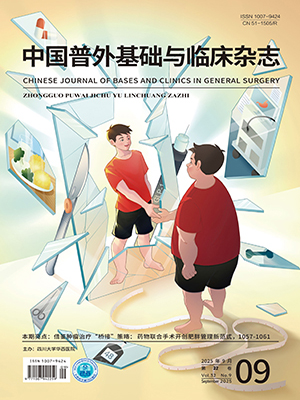| 1. |
McLeod DS, Cooper DS. The incidence and prevalence of thyroid autoimmunity. Endocrine, 2012, 42(2): 252-265.
|
| 2. |
Kravchenko V, Zakharchenko T. Thyroid hormones and minerals in immunocorrection of disorders in autoimmune thyroid diseases. Front Endocrinol (Lausanne), 2023, 14: 1225494. doi: 10.3389/fendo.2023.1225494.
|
| 3. |
Xu T, Zheng X, Wei T. Preoperative preparation for Graves’ disease. Front Endocrinol (Lausanne), 2023, 14: 1234056. doi: 10.3389/fendo.2023.1234056.
|
| 4. |
Klubo-Gwiezdzinska J, Wartofsky L. Hashimoto thyroiditis: an evidence-based guide to etiology, diagnosis and treatment. Pol Arch Intern Med, 2022, 132(3): 16222. doi: 10.20452/pamw.16222.
|
| 5. |
Chaker L, Razvi S, Bensenor IM, et al. Hypothyroidism. Nat Rev Dis Primers, 2022, 8(1): 30. doi: 10.1038/s41572-022-00357-7.
|
| 6. |
Zhai M, Zhang D, Long J, et al. The global burden of thyroid cancer and its attributable risk factor in 195 countries and territories: a systematic analysis for the Global Burden of Disease Study. Cancer Med, 2021, 10(13): 4542-4554.
|
| 7. |
Lee S, Lee H, Lee CH, et al. Comorbidities in alopecia areata: a systematic review and meta-analysis. J Am Acad Dermatol, 2019, 80(2): 466-477.
|
| 8. |
Fukuyama M, Ito T, Ohyama M. Alopecia areata: current understanding of the pathophysiology and update on therapeutic approaches, featuring the Japanese Dermatological Association guidelines. J Dermatol, 2022, 49(1): 19-36.
|
| 9. |
Zhou C, Li X, Wang C, et al. Alopecia areata: an update on etiopathogenesis, diagnosis, and management. Clin Rev Allergy Immunol, 2021, 61(3): 403-423.
|
| 10. |
Mancino G, Miro C, Di Cicco E, et al. Thyroid hormone action in epidermal development and homeostasis and its implications in the pathophysiology of the skin. J Endocrinol Invest, 2021, 44(8): 1571-1579.
|
| 11. |
Lintzeri DA, Constantinou A, Hillmann K, et al. Alopecia areata—current understanding and management. J Dtsch Dermatol Ges, 2022, 20(1): 59-90.
|
| 12. |
Bogus?awska J, Godlewska M, Gajda E, et al. Cellular and molecular basis of thyroid autoimmunity. Eur Thyroid J, 2022, 11(1): e210024. doi: 10.1530/ETJ-21-0024.
|
| 13. |
Alhanshali L, Buontempo MG, Lo Sicco KI, et al. Alopecia areata: burden of disease, approach to treatment, and current unmet needs. Clin Cosmet Investig Dermatol, 2023, 16: 803-820.
|
| 14. |
Xing L, Dai Z, Jabbari A, et al. Alopecia areata is driven by cytotoxic T lymphocytes and is reversed by JAK inhibition. Nat Med, 2014, 20(9): 1043-1049.
|
| 15. |
黃園園, 劉亞楠, 于世鵬. CD4+ T淋巴細胞相關細胞因子與橋本氏甲狀腺炎發病機制的研究進展. 中華診斷學電子雜志, 2019, 7(3): 214-216.
|
| 16. |
Wan S, Xu W, Xie B, et al. The potential of regulatory T cell-based therapies for alopecia areata. Front Immunol, 2023, 14: 1111547. doi: 10.3389/fimmu.2023.1111547.
|
| 17. |
Zhang QY, Ye XP, Zhou Z, et al. Lymphocyte infiltration and thyrocyte destruction are driven by stromal and immune cell components in Hashimoto’s thyroiditis. Nat Commun, 2022, 13(1): 775. doi: 10.1038/s41467-022-28120-2.
|
| 18. |
Hamed FN, ?strand A, Bertolini M, et al. Alopecia areata patients show deficiency of FOXP3+CD39+ T regulatory cells and clonotypic restriction of Treg TCRβ-chain, which highlights the immunopathological aspect of the disease. PLoS One, 2019, 14(7): e0210308. doi: 10.1371/journal.pone.0210308.
|
| 19. |
Zheng H, Xu J, Chu Y, et al. A global regulatory network for dysregulated gene expression and abnormal metabolic signaling in immune cells in the microenvironment of Graves’ disease and hashimoto’s thyroiditis. Front Immunol, 2022, 13: 879824. doi: 10.3389/fimmu.2022.879824.
|
| 20. |
Bain KA, McDonald E, Moffat F, et al. Alopecia areata is characterized by dysregulation in systemic type 17 and type 2 cytokines, which may contribute to disease-associated psychological morbidity. Br J Dermatol, 2020, 182(1): 130-137.
|
| 21. |
張曉麗, 劉毅. 斑禿免疫學發病機制及治療進展. 臨床皮膚科雜志, 2021, 50(2): 125-128.
|
| 22. |
Van Acker MM, Schwartz RR, Andrews K, et al. Inheritance-specific dysregulation of Th1- and Th17-associated cytokines in alopecia areata. Biomolecules, 2023, 13(9): 1285. doi: 10.3390/biom13091285.
|
| 23. |
Connell SJ, Jabbari A. The current state of knowledge of the immune ecosystem in alopecia areata. Autoimmun Rev, 2022, 21(5): 103061. doi: 10.1016/j.autrev.2022.103061.
|
| 24. |
Renert-Yuval Y, Pavel AB, Del Duca E, et al. Scalp biomarkers during dupilumab treatment support Th2 pathway pathogenicity in alopecia areata. Allergy, 2023, 78(4): 1047-1059.
|
| 25. |
Petukhova L, Duvic M, Hordinsky M, et al. Genome-wide association study in alopecia areata implicates both innate and adaptive immunity. Nature, 2010, 466(7302): 113-117.
|
| 26. |
胡默然, 沈捷. 不同類型自身免疫性甲狀腺疾病與人類白細胞抗原基因的關系及機制研究進展. 實用臨床醫藥雜志, 2021, 25(6): 123-127.
|
| 27. |
Xin C, Sun X, Lu L, et al. Increased incidence of thyroid disease in patients with alopecia areata: a systematic review and meta-analysis. Dermatology, 2020, 236(3): 251-254.
|
| 28. |
Catak MC, Akcam B, Bilgic Eltan S, et al. Comparing the levels of CTLA-4-dependent biological defects in patients with LRBA deficiency and CTLA-4 insufficiency. Allergy, 2022, 77(10): 3108-3123.
|
| 29. |
Vargas-Uricoechea H. Molecular mechanisms in autoimmune thyroid disease. Cells, 2023, 12(6): 918. doi: 10.3390/cells12060918.
|
| 30. |
Weetman AP. An update on the pathogenesis of Hashimoto’s thyroiditis. J Endocrinol Invest, 2021, 44(5): 883-890.
|
| 31. |
Walter K. Common causes of hair loss. JAMA, 2022, 328(7): 686. doi: 10.1001/jama.2022.12461.
|
| 32. |
Toussi A, Barton VR, Le ST, et al. Psychosocial and psychiatric comorbidities and health-related quality of life in alopecia areata: a systematic review. J Am Acad Dermatol, 2021, 85(1): 162-175.
|
| 33. |
Vargas-Uricoechea H, Nogueira JP, Pinzón-Fernández MV, et al. The usefulness of thyroid antibodies in the diagnostic approach to autoimmune thyroid disease. Antibodies (Basel), 2023, 12(3): 48. doi: 10.3390/antib12030048.
|
| 34. |
李亞潔. 甲狀腺自身抗體在自身免疫性甲狀腺疾病診斷中的應用價值. 臨床醫學研究與實踐, 2022, 7(4): 99-101.
|
| 35. |
楊瑩, 徐艷艷, 陳曉紅, 等. 斑禿患者血清中甲狀腺自身抗體、促甲狀腺素及甲狀腺激素水平的測定與分析. 臨床皮膚科雜志, 2018, 47(3): 145-149.
|
| 36. |
Lee S, Lee YB, Kim BJ, et al. Screening of thyroid function and autoantibodies in patients with alopecia areata: a systematic review and meta-analysis. J Am Acad Dermatol, 2019, 80(5): 1410-1413.
|
| 37. |
Kinoshita-Ise M, Martinez-Cabriales SA, Alhusayen R. Chronological association between alopecia areata and autoimmune thyroid diseases: a systematic review and meta-analysis. J Dermatol, 2019, 46(8): 702-709.
|
| 38. |
Holmes S, Harries M, Macbeth AE, et al. Alopecia areata and risk of atopic and autoimmune conditions: population-based cohort study. Clin Exp Dermatol, 2023, 48(4): 325-331.
|
| 39. |
Boelaert K, Newby PR, Simmonds MJ, et al. Prevalence and relative risk of other autoimmune diseases in subjects with autoimmune thyroid disease. Am J Med, 2010, 123(2): 183.e1-e9. doi: 10.1016/j.amjmed.2009.06.030.
|
| 40. |
Dai YX, Tai YH, Chang YT, et al. Bidirectional association between alopecia areata and thyroid diseases: a nationwide population-based cohort study. Arch Dermatol Res, 2021, 313(5): 339-346.
|
| 41. |
Moseley IH, Thompson JM, George EA, et al. Immune-mediated diseases and subsequent risk of alopecia areata in a prospective study of US women. Arch Dermatol Res, 2023, 315(4): 807-813.
|
| 42. |
Gharaei Nejad K, Motamed B, Hassanzadeh Rad A, et al. Dermoscopic findings of alopecia in patients with hypothyroidism. Int J Endocrinol Metab, 2022, 20(4): e128938. doi: 10.5812/ijem-128938.
|
| 43. |
van Beek N, Bodó E, Kromminga A, et al. Thyroid hormones directly alter human hair follicle functions: anagen prolongation and stimulation of both hair matrix keratinocyte proliferation and hair pigmentation. J Clin Endocrinol Metab, 2008, 93(11): 4381-4388.
|
| 44. |
O’Sullivan JDB, Nicu C, Picard M, et al. The biology of human hair greying. Biol Rev Camb Philos Soc, 2021, 96(1): 107-128.
|
| 45. |
Liu LP, Li MH, Zheng YW. Hair follicles as a critical model for monitoring the circadian clock. Int J Mol Sci, 2023, 24(3): 2407. doi: 10.3390/ijms24032407.
|
| 46. |
Dinh K, Wang Q. A probabilistic Boolean model on hair follicle cell fate regulation by TGF-β. Biophys J, 2022, 121(13): 2638-2652.
|
| 47. |
Popa A, Carsote M, Cretoiu D, et al. Study of the thyroid profile of patients with alopecia. J Clin Med, 2023, 12(3): 1115. doi: 10.3390/jcm12031115.
|
| 48. |
Park SM, Oh YJ, Lew BL, et al. The association among thyroid dysfunction, thyroid autoimmunity, and clinical features of alopecia areata: a retrospective study. J Am Acad Dermatol, 2019, 81(2): 602-605.
|
| 49. |
李勝華, 張桂英, 文海泉. 甲狀腺功能亢進并發斑禿及白癜風1例. 嶺南皮膚性病科雜志, 2007, 14(6): 368-368.
|
| 50. |
鄭玉明, 程霞. 斑禿患者血清甲狀腺激素水平測定. 放射免疫學雜志, 2003, 16(3): 167.
|
| 51. |
Hussein RS, Atia T, Bin Dayel S. Impact of thyroid dysfunction on hair disorders. Cureus, 2023, 15(8): e43266. doi: 10.7759/cureus.43266.
|
| 52. |
N?st TH, Alcala K, Urbarova I, et al. Systemic inflammation markers and cancer incidence in the UK Biobank. Eur J Epidemiol, 2021, 36(8): 841-848.
|
| 53. |
Ginckels P, Holvoet P. Oxidative stress and inflammation in cardiovascular diseases and cancer: role of non-coding RNAs. Yale J Biol Med, 2022, 95(1): 129-152.
|
| 54. |
Bauer AT, Gorzelanny C, Gebhardt C, et al. Interplay between coagulation and inflammation in cancer: limitations and therapeutic opportunities. Cancer Treat Rev, 2022, 102: 102322. doi: 10.1016/j.ctrv.2021.102322.
|
| 55. |
Tabatabaei-Panah PS, Moravvej H, Arian S, et al. Overlapping and distinct FAS/FASLG gene polymorphisms in alopecia areata in an iranian population. Immunol Invest, 2020, 49(1-2): 204-214.
|
| 56. |
Daripally S, Peddi K. Differential cancer risk and survival in Indian oral cancer patients with genic region FAS and FASL polymorphisms. Oral Surg Oral Med Oral Pathol Oral Radiol, 2022, 133(3): 315-325.
|
| 57. |
Hoxhaj I, Vukovic V, Boccia S, et al. Single nucleotide polymorphisms and the risk of developing a second primary cancer among head and neck cancer patients: a systematic literature review and meta-analysis. BMC Cancer, 2021, 21(1): 660. doi: 10.1186/s12885-021-08335-0.
|
| 58. |
Lee JH, Song Y, Do Han K, et al. Cancer risk by the subtype of alopecia. Sci Rep, 2018, 8(1): 9748. doi: 10.1038/s41598-018-28142-1.
|
| 59. |
Phan K, Smith SD. 26 841 Alopecia areata and risk of cancer varies based on type of malignancy. J Am Acad Dermatol, 2021, 85(3): AB25.
|




